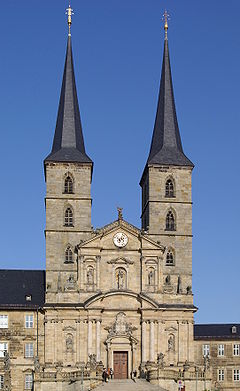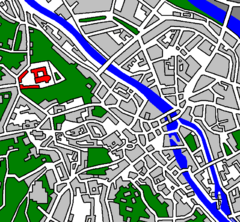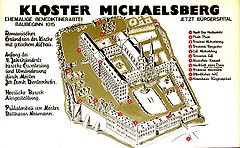- Michaelsberg Abbey, Bamberg
-
- for Michaelsberg Abbey in North Rhine-Westphalia, see Michaelsberg Abbey, Siegburg
Michaelsberg Abbey or Michelsberg Abbey, also St. Michael's Abbey, Bamberg (German: Kloster Michaelsberg or Michelsberg) is a former Benedictine monastery in Bamberg in Bavaria, Germany. After its dissolution in 1803 the buildings were used for the almshouse Vereinigte Katharinen- und Elisabethen-Spital, which is still there as an old people's home. The former abbey church remains in use as the Michaelskirche.
Contents
Abbey
After the creation of the Bishopric of Bamberg by Emperor Henry II, the first Bishop of Bamberg, Eberhard I, founded the abbey in 1015 as the bishop's private monastery. Accordingly the abbot answered directly to the bishop of Bamberg, and to no-one else. The monks for the new establishment were drawn from Amorbach Abbey and Fulda Abbey.
The abbey soon flourished under Bishop Otto (d. 1139), whose burial in the abbey church and subsequent canonisation in 1189, together with the papal protection granted to the abbey in 1251, was of enormous advantage in increasing the independence of the abbey from the bishops. The award to the abbots of the pontificalia had taken place some time before 1185. The abbey's financial status rested securely upon its great ownership of lands in 441 places in the bishopric.
In 1435 the abbey came into conflict with the townspeople of Bamberg and was plundered. It also suffered during the German Peasants' War of 1525, the Franconian Markgräflerkrieg and from an occupation of several years' duration by the Swedish army during the Thirty Years' War. In the 17th and 18th centuries the abbey recovered, and enjoyed a new period of prosperity.
By the time of the secularisation of Bavaria of 1802 the abbey still owned substantial property in Bamberg itself as well as estates in no fewer than 141 places in the surrounding area. On 30 November 1802 Bavarian troops confiscated the abbey's assets. Valuable books were removed to the library of the Bavarian court, the predecessor of the present Bayerische Staatsbibliothek. The 24 monks then resident were obliged to leave the monastery. The abbey buildings passed into the possession of the city of Bamberg, who by popular request transferred into them the old almshouses from the city centre; these are still located there.
Abbey church
The first church on the site, dedicated to Saint Michael, was built in about 1015 and was destroyed by an earthquake, probably in 1117. The present building is basically a Romanesque church, consecrated in 1121. In 1610 it was badly damaged by a fire, as a result of which the nave (with its ceiling paintings of the Garden of Heaven, completed in 1617) and the westwork, with the two west towers, had to be more or less rebuilt from scratch. The still-extant organ-loft was also constructed very soon after the fire, in 1610, and is a significant work of the German Late Renaissance. From 1696 Leonhard Dientzenhofer, under the instructions of abbot Christoph Ernst, created a two-storey Baroque exterior facade. Johann Dientzenhofer built the terrace in 1723.
In 1833, on the orders of King Ludwig I of Bavaria, the gravestones and memorials of the bishops of Bamberg from the 16th to the 18th century were removed from Bamberg Cathedral and set up in the Michaelskirche, as described in a guidebook of 1912:[1]
- "An entirely alien component of the church furnishings consists of those episcopal gravestones which Ludwig I ordered to be removed from the cathedral during its restoration, as stylistically inappropriate, and which were set up in the Michelskirche instead."[2]
The former abbey church of Saint Michael is now an ancillary church to the cathedral.
Notes
See also
- Historical Museum Bamberg
References
- Peter Schneider und Wilhelm Ament: Bamberg. Speyer, 1912.
- Peter Ruderich: Ehemalige Benediktinerabteikirche St. Michael in Bamberg. DKV-Kunstführer Nr. 614/3 Deutscher Kunstverlag München Berlin
- Anja Hofmann: Sakrale Emblematik in St. Michael zu Bamberg. Verlag Harrassowitz (2002), ISBN 3447044136 .
Sources and external links
- Klöster in Bayern: Kloster Michaelsberg, Bamberg (German)
- 1614 Umbaumaßnahmen am Michelsberg (Building alterations on the Michelsberg) (German)
Coordinates: 49°53′37″N 10°52′38″E / 49.8936111111°N 10.8772222222°E
Categories:- Benedictine monasteries in Germany
- Monasteries in Bavaria
- 1015 establishments
- 1803 disestablishments
- Buildings and structures in Bamberg
- Churches in Bavaria
Wikimedia Foundation. 2010.




